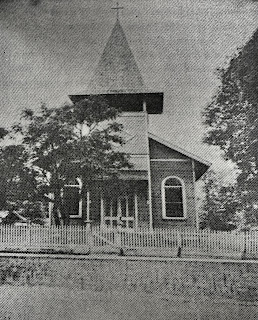 |
| Ronald Harrell looking at photographs with Bill Dorman Photo Credit: Antoinette Harrell |
 |
| Bill Dorman Amite Genealogy Department Photo Credit: Antoinette Harrell |
 |
| Ronald Harrell looking at photographs with Bill Dorman Photo Credit: Antoinette Harrell |
 |
| Bill Dorman Amite Genealogy Department Photo Credit: Antoinette Harrell |
 |
| Kentwood Museum Historical Redevelopment Museum Photo Credit: Antoinette Harrell |
West Baton Parish was built on the sugarcane industry. The West Baton Rouge Museum is the only museum to preserve the
 |
| Ronald Harrell-President Antoinette Harrell-Vice President Kentwood Historical Museum Redevelopment Committee Photo Credit: Connor Lacoste |
 |
| Kentwood Summer Campers Art Exhibit Jordan Wilkerson Photo Credit: ANTOINETTE HARRELL |
One solution is to integrate art projects into other subjects, such as using drawings to visualize scientific concepts or historical events. Schools could also partner with local artists and art organizations to provide workshops and special programs.
 |
| Artist Mia Marshall Art Instructor Photo Credit: ANTOINETTE HARRELL |
Displaying their artwork at Kentwood City Hall and our local library will be a great place to display their artwork.
 |
| The infamous Kudzu Kentwood, Louisiana |
Yes, kudzu
It is said that kudzu roots have 10 amazing health benefits. It
Link to learn more about
 |
| Old Sweet Home Baptist Church Photo Credit: Antoinette Harrell |
They believed in God and with this belief the first Church was organized in the late 1880s. The name Sweet Home could have been chosen because the first meetings took place in a home located northeast of town, on the east side of Cook Creek. Mrs. Hazel Kinzy recalls here step-father, Mr. Willis Bates, talking about the church being held in Buck Town in a field. The Church existed for years in this location. Some of the pioneer families are buried there. Although a majority of those pioneers could neither read or write, they were possessed with and innate intelligence by which they were able to carry on successfully. It was such a faith and devotion that brought them through those trying years of the reconstruction era.
The building also served as a school consisting of primary through fourth grade. Mrs. Ruby Hookfin and Mrs. Inez Hookfin recall having to cross Cool Creek to attend School in the frame building. Mrs. Emma Buckhalter was the only teachers.
Some of the casualties from the terrible train wreck of November 1903 were buried in the Sweet Home Baptist Church area. In 1904 Hon. William H. Scanlon came to Kentwood as head bookkeeper for the Brooks-Scalon Mill. He arranged a building to be erected, with the debt to be satisfied by deducting $1. 00 from each church members employed at the mill. After sometime, the mill owner decided this would take too long and declared the bill paid in full for the building only.
 |
| Sweet Home Baptist Church Cemetery |
Other pastors who have served are: Bradley (1916-1921), Bolivar (1921-1926), B. Robertson (1926-1935), Tobias (1935-1951), John Thompson (1951) to present. Second and fourth Sundays were service days, with Sunday School being conducted every Sunday.
Thanks to Ms. Della Mae Wilson, a cash deed int eh amount of thirty-five dollars was paid to the Estate of J. H. Ellis for one acres of land. Witnesses were: Aquila Sibley, T.G. Womack, James H. Brumfield, Mrs. Emily. E. Owens, Mrs. M.K. Ellis, and Herbert Broyles, Notary Public.
The original frame building was first improved with concrete blocks, then bricked under the leadership of Reverend John Thompson. Interior improvements have also been made. We have come from torches to the comfort of electricity, air conditioning, drinking water fountains, carpets and comfortable pews. The pastor and choir have been robed, new collection plates and communion set have been purchased.
Deaconess who served are: Hazel Kinzy, Grace Andrews, Vetra Brumfield, Emily Ware, Emma Taylor, Katie Brumfield, Beatrice Brumfield, and Annie Mae Strickland.
Deacons have been: V.O. Brumfield, I.V. Kinzy, Willie Joe Ferdinand, Paul Robertson, Leo Andrews, Conrad Wyre, Wallace Brumfield, Ike Strickland and Henry Mercelous. Founding Father and Board of Trustees: Betty Perkins, Della Roman and Willis Bates. The Willing Workers Club composed of women who raised the money to move the church. The Women's Amite River Baptist Association had its birth at our church in the year 1948. Two members, the late Lois Marcellus and Fochia V. Wilson has served as president of this organization. Elmira Wilkerson was one the first musicians in later years. Others who have followed are: Fannie Ard, Amos Addison, Yvonne Brumfield, Jerry Marcellus, Rev. Crosan, Rev. Michael Williams, Fannie and Emma McClendon.
 |
| Sweet Home Baptist Church Cornerstone Photo Credit: Antoinette Harrell |
Source: Reprint from an article written and submitted by Mrs. Fochia V. Wilson
 |
| St. Elizabeth Catholic Church Photo Courtesy: Randy Konzelman |
St. Elizabeth Church is no longer in Kentwood. I remember when they were moving the old beautiful structure. It was said that they took it to Amite, Louisiana. I'm not sure, that was said. It use to be located at 404 Avenue C, Kentwood, LA. According to churcheslist.com, it was the only Catholic Church in Kentwood.
Ronald Harrell looking at photographs with Bill Dorman Photo Credit: Antoinette Harrell Genealogist Antoinette Harrell arranged a tour of th...
